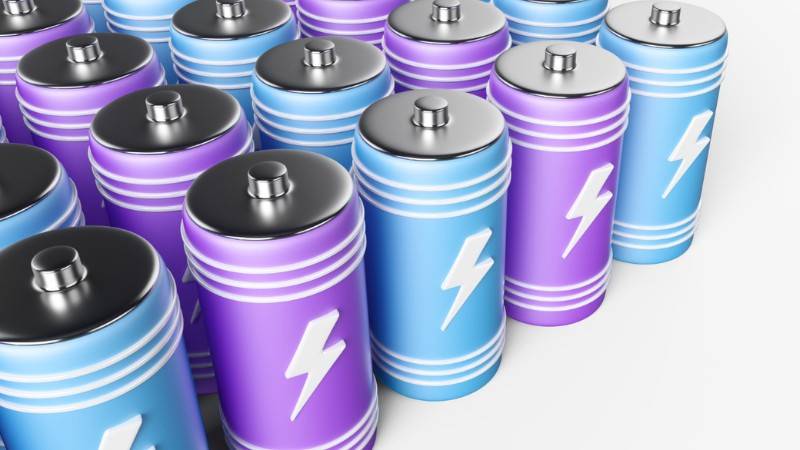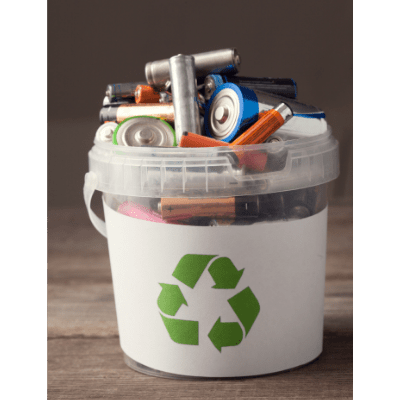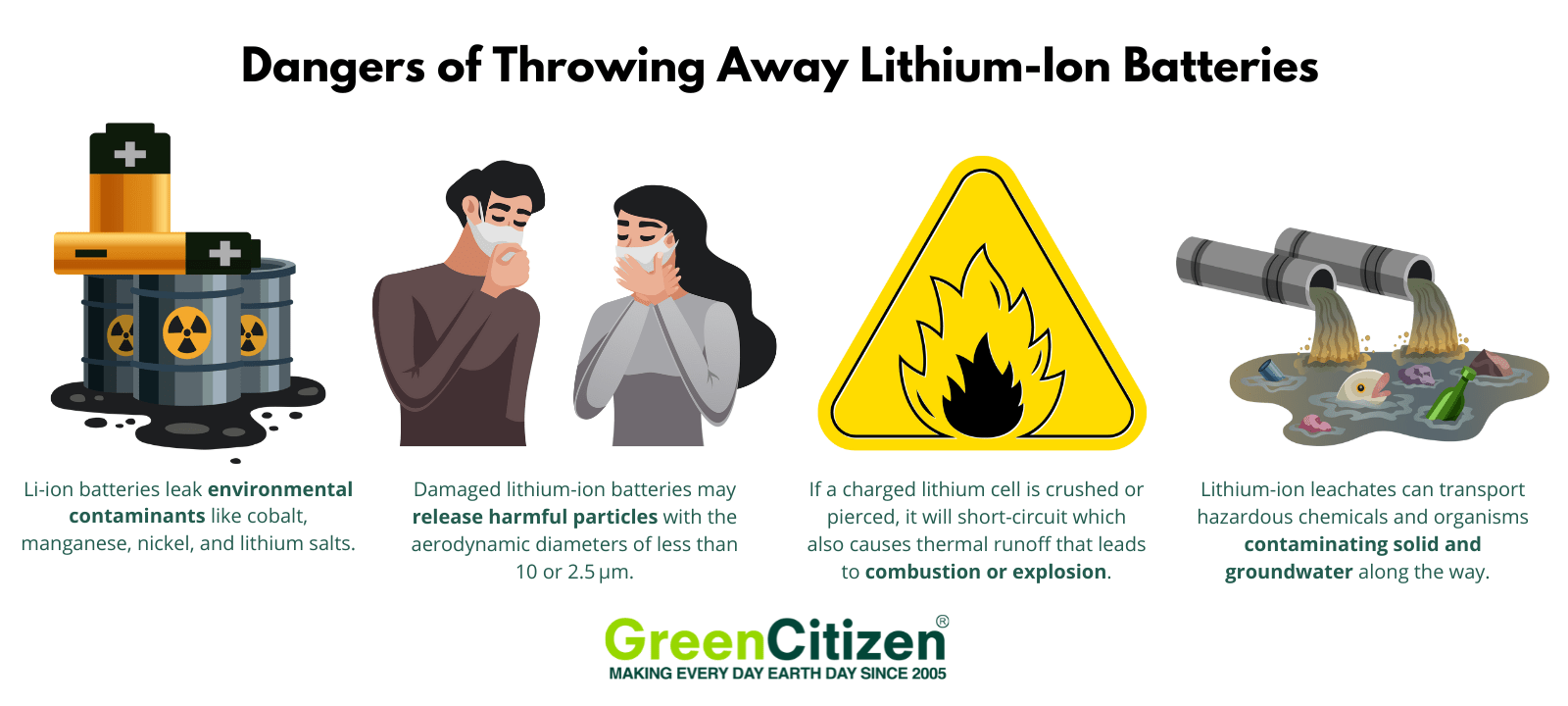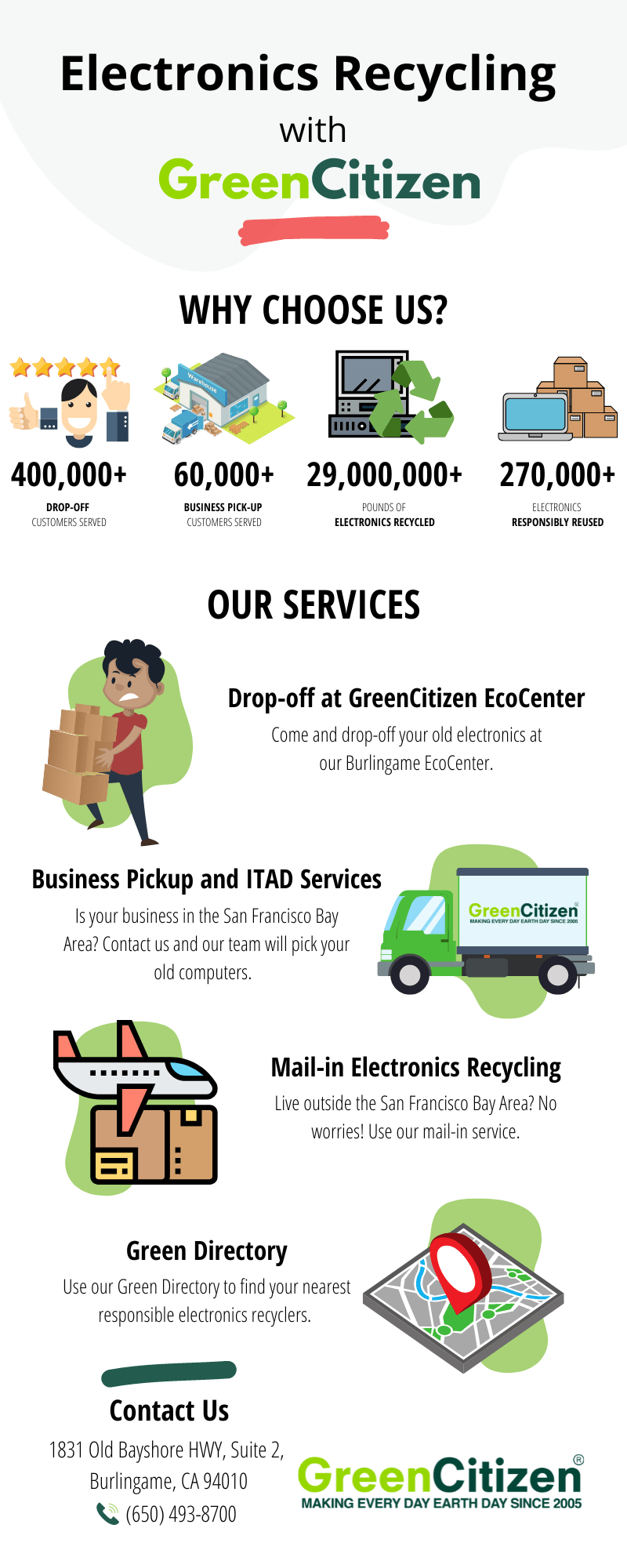Lithium-Ion Battery Recycling: The Complete Guide
by : Nikola Gemeš | Publication Date: August 10, 2023
Many of our gadgets and electronics run on lithium-ion batteries, but most people don’t know how to dispose of them safely once those gadgets die. Here’s how you actually do it.

Used batteries have been a problem for decades from both household and industrial waste perspectives. While battery technology has changed a lot, even the most advanced rechargeable lithium-ion batteries may still contain materials that are considered hazardous.
It’s not only environmental pollution that is a problem. During the end-of-life stage of any modern electronic device, poor handling, storage, and disposal could increase the risk of fire or poisoning.
A much bigger problem is that the real “battery crisis” is still ahead of us. And we’re not just talking about li-Ion power banks for your phone.
Disposing of huge numbers of batteries from electric vehicles is going to be the real challenge — one we should master using the recycling technology we have today.
Fortunately, lithium-ion battery recycling is starting to become a widespread practice.
Here’s how you can do your part.
Can You Recycle Lithium-Ion Batteries?
Yes, lithium-ion batteries are recyclable, but the process is a bit complicated. This might be the reason why you’re struggling to find a recycling center that processes this kind of waste.
The first challenge to lithium battery recycling is that you can’t handle those batteries like any other electronic waste.
Lithium is a highly reactive element.
To leave chemistry aside, let’s just say that dumping a lithium battery into a load of paper recycling wouldn't be the smartest thing to do.
Increased heat or electric discharge can cause the power cells to burst into flames. Cases like this are rare but are being reported increasingly often.
Even when done properly, stockpiling of water li-ion batteries is potentially unsafe and environmentally risky. Unlike other materials, these batteries can’t be reused directly, so recycling is the only viable solution. In addition, lithium battery recycling reduces the need for new mineral extraction, which is always a win for the environment.
So how is recycling done?
First, qualified technicians need to disassemble batteries into modules. These professionals are trained high-voltage specialists who use insulated tools to avoid electrocution or short-circuiting the pack.
Short-circuiting a lithium-ion battery is no picnic. It may lead to rapid discharge and overheating that in return generate noxious byproduct gasses that may cause a cell to explode.
You don’t even want me to go on about the cocktail of carcinogenic electrolyte additives that get released into the environment this way.
Once they take them apart, technicians assess which cells still have enough health for reuse in other applications and which need recycling.
The most important point is that you need to find a qualified e-waste recycler that can handle and recycle li-ion batteries safely and responsibly.
Can You Throw Away Lithium-Ion Batteries? Understanding the Impact
No, you can’t throw away lithium-ion batteries with your regular trash.
Not even in your blue recycling bin!
Let me tell you why.
Heavy Metals They Contain Are Environmental Hazard
There is some confusion out there when it comes to lithium-ion batteries and their environmental impact.
Big electronic manufacturers often refer to studies about how lithium is one of the least toxic metals utilized in batteries, and there's a certain amount of truth to that.
But, as always, you need to take those claims with a (big) grain of salt.
Some types of li-ion batteries contain metals that are highly damaging even in relatively small quantities when these batteries are broken down.
When these batteries end up in landfills, they leak environmental contaminants like cobalt, manganese, and nickel. Not to mention hazardous lithium salts and plastics.
As if that’s not enough, lithium-ion batteries can start underground fires that can slowly burn for long periods, contaminating the surrounding trash with toxic chemicals.
Underground fires are difficult to detect and may create large voids in the landfill. This can cause the landfill surface to cave in, burying flammable electrolytes even deeper in the ground.
Yet an alarming 95% of lithium-ion batteries find their way to landfills!
All this makes little sense when we know that it’s fairly easy to remove more than 90% of cobalt and nickel from these batteries.
Thankfully, some lithium-ion battery technology is replacing cobalt with safer, non-toxic, and relatively common materials such as manganese oxide or phosphate.
Toxic To Humans When Broken Down or Damaged
We don’t have to wait for the batteries to end up in the landfill — they can be toxic even before they are packed with curbside trash.
Damaged lithium-ion batteries may release fine particles with the aerodynamic diameters of less than 10 or 2.5 μm — the notorious PM10 and PM2.5.
The problem is that these particles contain matter-bound metals like arsenic, cadmium, chromium, cobalt, copper, or lead.
Dust can enter the respiratory system and cause a variety of health problems, such as cardiovascular and respiratory conditions, carcinogenicity, and endocrine system imbalance.
Hydrofluoric acid (HF) is a hazardous gas that can leak from used-up lithium-ion batteries. HF is highly corrosive and can enter the human body through the skin or by inhaling. It readily penetrates the skin and settles in deeper layers where it releases its toxic components.
It is estimated that between 20 and 200 mg of HF can be released per W of the electric vehicle battery pack.
This easily amounts to more than 80-800 times the US National Institute for Occupational Safety and Health Immediate Danger to Life or Health (IDLH) level.
Do not under any circumstance try to take apart a lithium-ion battery!
Leave it to the professionals who know how to protect themselves and the environment.
Potential Fire Hazard
Proper disposal is also important because lithium-ion batteries can pose a fire hazard when handled or stored improperly.
At GreenCitizen, over 95% of the exploded or bulging batteries that we get are from Apple products that use the Lithium Polymer (LiPo) style.
Some of us still remember the Samsung Galaxy Note 7 recall when improperly designed li-ion batteries were prone to overheating and exploding.
This effect is called the thermal runoff — a lithium cell basically self-heats, bulges, and combusts.
The problem is not going away by itself.
Veolia, one of the global waste handling companies has noted a 38% increase in fire incidents since 2017, due to the presence of lithium-ion batteries in the waste stream.
The UK Environmental Services Association estimates that nearly 250 fires in the country’s waste treatment centers were caused by small Li-ion batteries between 2019 and 2020.
The German Steel Recyclers Conferedation (BDSV) has reported a whopping 90% of fires at their associated sites in 2020 caused by Li-ion batteries.
But how can this happen?
If a charged lithium cell is crushed or pierced, it will short-circuit which also causes thermal runoff that leads to combustion or explosion.
This is one of the great challenges in lithium-ion battery recycling. You need to do it safely, because setting fire to all the materials you want to recycle is not the best way of recycling.
Can Contaminate Groundwater
Leachate is one of the most serious hazards related to landfilling. Leachate is a result of biological, and chemical processes and rainwater seeping through the waste.
Leachate can transport hazardous chemicals and organisms over considerable distances contaminating solid and groundwater along the way.
Lithium-ion leachates potentially carry pollutants like heavy metals, additives, electrolyte degradation byproducts, but also dissolved gasses such as HF, HCl, or SO2.
These elements are not only outright toxic but also change the properties of groundwater.
Their acidification can have the same effect as “acid rain”, lowering the pH and impacting plants and animals.
How to Tell If Your Li-ion Battery is Bad/Damaged?
With all the potential safety hazards, you need to know when your lithium-ion battery is done for.
If you notice any of the symptoms we’ll go through below, don’t wait to replace the battery and make sure the old one gets properly recycled.
The Voltage and/or Capacity Drops
Check what kind of lithium battery you have and find the manufacturer’s specs. This is where you can find info on voltage and capacity. Then try to measure the voltage and resistance when fully charged. Here’s the way to do it for a laptop battery.
If these values match with the manufacturer’s specs, you’re good to go. If not, start looking for a replacement.
The Battery Self-Discharges Quickly
All batteries self-discharge, which means they lose charge even when not working to power up a device. Lithium-ion batteries in good condition, however, usually don’t self-discharge quickly.
If you’re suspecting that your battery is bad, leave it disconnected from the device for a couple of hours. Measure the charge capacity before and after disconnecting.
If the numbers go beyond the manufacturer’s provided values, your battery has probably gone bad.
The Battery Overheats
Overheating is one of the most common signs of a bad lithium-ion battery. Still, make sure to check the specs of the battery to see its normal operating temperature.
Batteries get hot with heavy use, but if the temperature is way higher than what the spec sheet says, you risk not only damaging the battery but also the device it’s powering.
Bloating
If you missed the previous three alarms, bloating is a sure sign that you should immediately stop using the lithium-ion battery. There’s little you can do but look for the nearest recycling center that will take it off your hands.
Unfortunately, when it comes to bloating, there are chances that the battery has damaged the device as it tried to force its way out.
How To Recycle Lithium-Ion Batteries
As we have seen so far, unauthorized handling or even worse trying to disassemble or recycle lithium-ion batteries can lead to a number of environmental and health hazards.
What It Takes for Proper Lithium-Ion Battery Recycling
Registered and qualified e-waste recyclers that accept lithium-ion batteries use complex and energy-demanding processes that include pyrometallurgy and hydrometallurgy.
In pyrometallurgy, battery components are smelted in a high-temperature process that burns and separates a mixed metal alloy of cobalt, copper, iron, and nickel.
Hydrometallurgy recovers the desired metals by treating the cathode material with an acidic or basic solution.
Finally, there’s a direct recycling procedure in which materials from spent lithium cells are directly reused after conditioning.
All these procedures require skilled technicians and considerable investment in processing facilities.
Dishonest Practices
Unfortunately, wherever there is a potential to make a profit there are attempts to bypass the official lithium-ion battery recycling routes, as it’s already happening with the rest of electronic waste.
Such activities result in the pollution around the processing site and poor working conditions that compromise employees’ health and quality of life.
Illegal disposals may also occur when proper recycling turns “too expensive” for some businesses who need lithium-battery waste taken off their hands ASAP.
These wild dumpsites can pop up in random places and cause severe pollution, unexpected fires, and huge costs to local councils to clean up and remediate the area.
Once again, the burden of illegal disposal falls on local economies.
The problem even gets worse if the lithium-battery waste is exported to developing countries for “processing”.
About two-thirds of global e-waste gets exported, but only about 18% of it is formally collected, managed, and documented.
There are no guarantees that exported lithium batteries will be recycled or processed in a regulated, safe, and eco-friendly way.
The One and Only Right Way for Lithium-Ion Battery Recycling
The only safe way to recycle Li-ion batteries is to have them processed by a qualified electric and electronic recycling center.
For individuals, that means looking up your nearest center and dropping off any old phones, games consoles, laptops, or tablets. These will generally be accepted free of charge and recycled properly.
The problem is that not all recycling centers accept lithium-ion batteries. Email inquiries and phone calls take a long time, provided you have already tracked down the suitable facilities in your area.
GreenCitizen has developed the Green Directory, as a one-stop service for finding recycling services. The service is easy to use:
- Enter what you need recycling, e.g. “lithium batteries”
- Punch in your zip-code
- Hit “search”
You’ll get a list of businesses that accept lithium batteries in your area. These might be big box stores, electronics retailers, or specialized recyclers.
If you live in the San Francisco Bay Area and want to safely recycle your lithium-ion batteries, take a look at GreenCitizen’s electronic recycling program.
With GreenCitizen, you can dispose of lithium-ion batteries in two ways:
Drop-off at GreenCitizen EcoCenter (for Residential Individuals Only)
Private residents are welcome to bring their lithium-ion batteries to our EcoCenter in Burlingame.
Our address is — 1831 Old Bayshore HWY, Suite 2, Burlingame, CA 94010 USA.
Your lithium-ion battery will be recycled responsibly and safely, with no hazardous leaks and discharges.
But we don’t stop at batteries. We also recycle computers, laptops, monitors, and tablets.
Business Recycling Pickup (for Businesses Only)
Businesses that have larger quantities of batteries to dispose of may be able to arrange a collection by a recycling center or other services, so it’s worth contacting them first.
Feel free to contact our Business Pickup Service to schedule a pickup.
If your company is in the San Francisco Bay Area, just post us a pickup request and we’ll get you taken care of.
On your part, you should:
- Place the batteries in an empty room or loading dock
- Please don't use paper wraps or packing peanuts for the risk of fire
- Take a photo of the shipment and mail it to our Account Managers
- Our logistic crew will drop by and load your batteries
- We’ll send you a confirmation that your batteries have been recycled
Our pickup service comes especially handy for large battery packs, like those that you can find in electric vehicles. It’s not that you can just pick them up and drop them off like any other electronic waste.
Dos And Don’ts When Recycling Lithium-Ion Batteries
Dos
- Whenever possible, remove the battery from the device.
- If the batteries are physically damaged, store them in an insulated plastic bag to avoid any short-circuiting.
- Keep them in a cool and dry place to avoid combustion.
- Bring them to a certified recycling provider who can safely deal with the hazardous materials they may potentially contain.
- Contact their manufacturer to see if there is an industry collection program for them
Don'ts
- Never dump used batteries into your regular waste.
- Don't crush or pierce the batteries as this can lead to leakage or short-circuiting.
- Don't store large quantities of li-ion batteries close together without capping or taping off exposed connectors.
- Never throw li-ion batteries in the regular blue recycling bin.
- Don't keep old batteries close to flammable materials.
FAQ
How much of a lithium ion battery can be recycled?
On average, about 50% of a lithium-ion battery can be recycled in an effective way. Unfortunately, this means that a considerable amount of the materials in it have to be safely stored in a permanent way. However, there have been some breakthroughs in recycling technology, with a Finish company developing energy-efficient processes to deal with up to 80% of the materials in rechargeable batteries.
How bad are lithium ion batteries for the environment?
Lithium-ion batteries are not necessarily bad for the environment; it's the metals in them that are, especially if one of those metals is cobalt. If they don’t go through proper recycling processes, then metals like cobalt and nickel can leak into the ground and cause groundwater pollution.
What happens to lithium ion batteries when they die?
When lithium-ion batteries die, the process that allows for ions to pass back and forth between electrodes slows down. This means that less energy can be stored, and you'll ultimately run out of power when you need it the most.
How long do lithium ion batteries last?
Lithium-ion batteries typically last about three years or 300 to 500 charge cycles before they get to a stage where they will no longer retain much energy.
Conclusion
Lithium-ion batteries are insanely useful, but it's important that you don’t unknowingly put yourself or others in danger because of them.
The fire hazards associated with them and the toxic metals that they contain could potentially lead to serious issues unless these batteries are properly recycled.
If you would like to recycle lithium-ion batteries, you can visit the Green Directory to find battery recycling drop-off centers near you.
You can also give us a call at GreenCitizen at (650) 493-8700 if you want to know more information about lithium batteries.
We thank you for doing your part for the environment!
Nikola Gemeš
Nikola uses his background in electrical engineering to break down complex sustainability topics for GreenCitizen's readers. He is a firm believer in environmental conservation, which he practices daily through recycling and home-grown food. He enjoys hiking, engaging in white-water sports, and collecting pocket knives.
| Thank you for Signing Up |


Category: Circular Economy, Environment, Green Blog, Home Environment, Most Popular






The recycling of batteries should not be difficult, especially if you want people to be concerned for the environment.
The future is grave if the young people of today take the hazardous wastes so lightly, because the toxic elements in almost ALL GREEN PRODUCTS will pollute the ground water when it leaks out!
These battery elements are worse than petroleum.
Pingback: Lithium-Ion Battery Recycling Market | Ledlights.blog
Pingback: What are the different applications Of LiFePO4 batteries? - Industrial News
Pingback: The Different Types Of Electric Car Batteries – OsVehicle
Pingback: Recycling of lithium batteries - Gain
A informative blog post after a long time on your website. Guys, keep posting these.
Pingback: A Information To Reusing Previous Lithium Batteries - Halakick
Pingback: A Guide To Reusing Old Lithium Batteries - ClimateBiz
Pingback: A Guide To Reusing Old Lithium Batteries - Climatebiz
Pingback: Are Electric Cars Better for the Environment? | Businesblog
Pingback: Are Electric Cars Better for the Environment? | Earth.Org – Past | Present – Chats Worth Auto Repair
Pingback: Are Electric Cars Better for the Earth?Earth.Org | Earth.Org – Past | Present – ReTime
“Lithium-ion batteries are becoming popular in electric vehicles & solar power. I was unaware of a lot of things about lithium batteries, but this blog gave a detailed guide on lithium-ion batteries & their recycling process.
Its important to know facts before buying any kind of lithium battery, Thank you for sharing the article. “
Pingback: O lado sombrio da extração de lítio para fabricar carros elétricos - Território Secreto
Pingback: O lado sombrio da extração de lítio para fabricar carros elétricos - Carro Elétrico
Pingback: How to Recycle VHS Tapes and Cassette Tapes: Complete Guide
Pingback: Utilimarc | Business Intelligence and Fleet Analytics
Pingback: Is The Caribbean Ready For Electric Cars? - CARILEC
Sadly, the only way to save our planet is to put the Genie back into the bottle.
The carbon cost of manufacturing electric equipment and vehicles is not recovered during their lives.
The problems of disposing of or recycling all kinds of battery are immense and barely being attended to yet.
20 or 30 years on the problem of deteriorating generating plants and replacement of solar cell arrays will geometrically compound our problems.
It is probably safer in the long term to stay with, and refine the usage of, carbon fuels.
As an elderly gent I type the above with great sadness.
So sorry but your research is wrong. To manufacture petroleum you must burn tons of fuel in the process. To clean up the environment we need to get rid of coal and oil burning. Electricity and batteries are far more cleaner than the open fires required to create petrol. The average vehicle puts 120gms carbon into the air per km.
On average, about 50% of a lithium-ion battery can be recycled in an effective way. This is especially true if they get exposed to dampness, heat, or accidental damage. Each of the cells within a battery is a separate unit, but even if one of them gets damaged, this could cause a chain reaction. This would then lead to harmful metals leaking out.
There is a new company American battery and metal that claims they can recycle 100 percent of lithium batteries with 0 waste
Most honest answer I’ve heard yet!!
This sounds great. Can you provide the source where they say that? I’m assuming you’re talking about American Battery Technology Company (ABTC)
So what’s your point? Keep polluting with coal and focal fuels?
Sounds like a Republican who drives a hummer.
You need to start doing your part by convincing others to do theirs by educating them with sound facts and not insults! Over the years I have found that most people actually have the same goals, it is how we get there that divides us. Just remember, we all need to pay a price whether we are rich, poor, Democrats, Republicans, of color or not… If we fail to do this we are destined for failure due to our ignorance.
So, stop being prejudiced by blaming it on the Republicans. I live in MA and of the ten states we have lived this is one of the worst when it comes to people actually practicing what they preach.
I do my part by placing my recyclables on the curb is not acceptable from anyone. WE ALL NEED TO DO OUR PART AND MORE, INCLUDING ME!
BTW I am an independent who cannot stomach the acts of either party at times.
I am a battery shopkeeper and always looking to get knowledge related batteries. Good to read your article, its full informative “Lithium-Ion Battery Recycling: Separating Fact from Fiction.”
Do you have literature on Recycling Dead Electric Car Batteries?
Dear Mr. Bolt
Please the recycle of huge Lithum batteries will cause sure pollution and no one can
guarantee 120 thousands ton of cars batteries with end of 2020 will be sucssefly
recycled , for cars batteries let’s waiting new batt. technology offer higher energy
less wait and environment friendly
Till that time nothing replace petrol cars
Regards
Mouhamed Alkhouja
mektric@hotmail.com
Great idea from a person with middle eastern ties!!!
The world is presently burning and Saudi Arabia says we need more burning of fossil fuels. Zero soot comes out of the rear of an EV. Yet, 100% of fossil fuel burning turns to carbon soot at a rate of 120gms per km. This versus 50% recycling rate for batteries is hugely different.
Global warming is a result of burning fossil fuels and coal. The key word is “burn”.
Global warming is ALSO a result of our over-populated planet, our use of chemicals (lawn sprays, herbicides, pesticides, etc.), the deforestation of rain forests, removal of old growth trees, landfills which give off toxic gasses, beef and other livestock production, and so on. Some humans rarely use their heads when it comes to climate change. Some even deny it is happening.
For heavy usage battery needed to power vehicles for human transportation, are batteries “greener” than fossil fuels and how do costs of maintenance, replacement, and disposal compare? Assume a twenty-year lifespan of vehicle. Thank you.
On average, about 50% of a lithium-ion battery can be recycled in an effective way. This is especially true if they get exposed to dampness, heat, or accidental damage. Each of the cells within a battery is a separate unit, but even if one of them gets damaged, this could cause a chain reaction. This would then lead to harmful metals leaking out.
GreenCitizen is an environmental conservation company providing you with information, services, and products to help you live a sustainable life.
Follow Us
Join Our Newsletter
Quick Links
Green News
Green Directory
Green Store
Blogs
Most Popular
Sustainable Living
Renewable Energy
Business & Polices
Environment
Product Review
Services(United States)
For Businesses
Business Pickups
Data Destruction
Build Wide Pickups
Product Destruction
For Homes
Electronics Recycling Drop-off
Mail-in Recycling
Hard Disk Destruction
How to Recycle ?
Useful Links
About Us
Contact
Careers
Customer Reviews
Our Customers
Press Room
In The News
LEED Reporting
E-waste Crisis
Data Security
Global Dumping
Harmful Effects
Styrofoam Recycling
Polyurethane Foam Recycling
Why Data Security ?
Copyright © 2023 · All Rights Reserved · GreenCitizen
Privacy Policy | Affiliate Disclosure